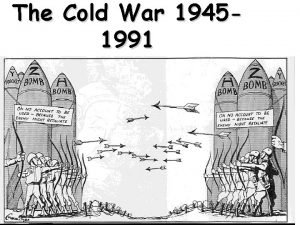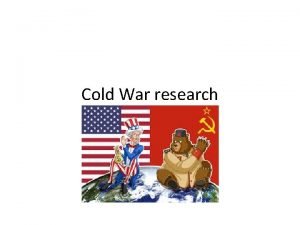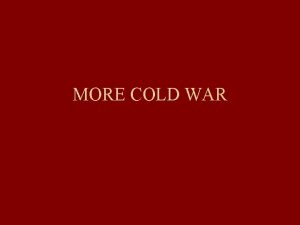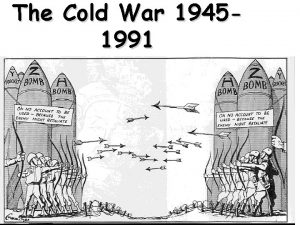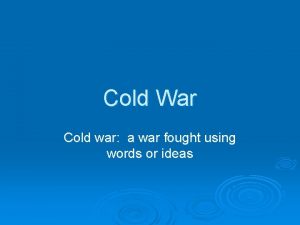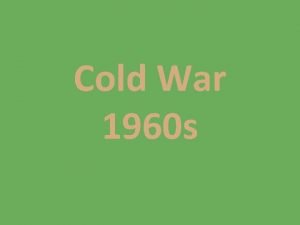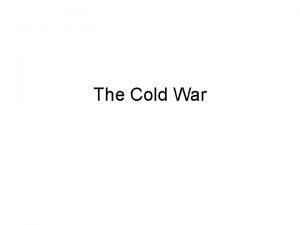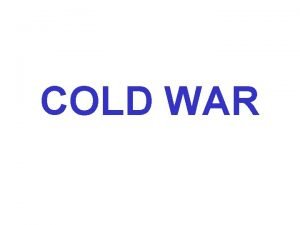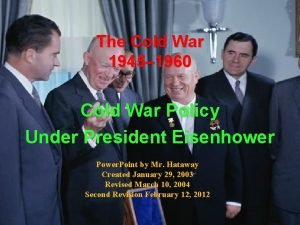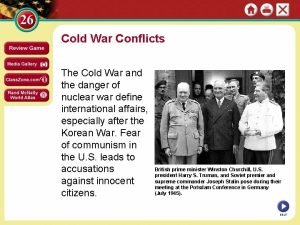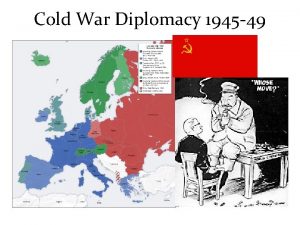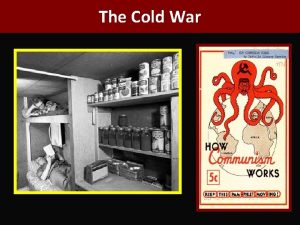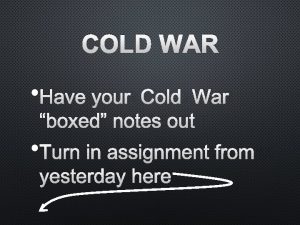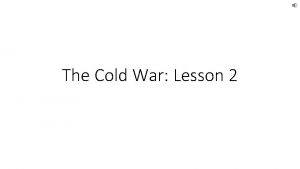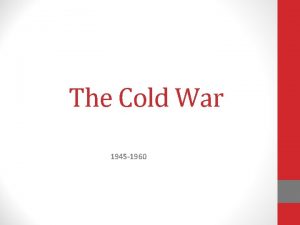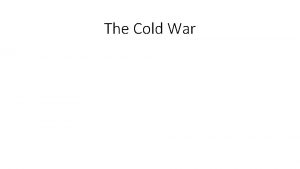Cold War Cold War The Cold War was








































- Slides: 40

Cold War

Cold War • The Cold War was a continuing state of tension and hostility between the United States and the Soviet Union. • • It started after World War II It was considered a “cold” war because armed battle between the superpowers did not occur. The United States feared communism and wanted to stop the Soviet Union from spreading it. Even though the United States and the Soviet Union never fought directly, they fought through other countries like in The Vietnam War and The Korean War. It was and arms race. Each country raced to have the most nuclear weapons. It eventually turned into and economic war with the United States winning. • •

Yalta Conference • • Cold War Postwar Plan • In February 1945 Roosevelt, Churchill and Stalin met in the Soviet Union to decide what was going to happen to Europe after World War Two They agreed to divide Germany into zones of occupation controlled by the Allied military forces, ( East and West ). France/Britain/United States- West Germany Soviet Union- East Germany • • •

• United Nations • When the UN was started • June 1945 US and Soviet Union joined with 48 other countries to form the UN • Why the UN was started • • The countries wanted a peacekeeping organization that could stop wars and protect the citizens of the world. All countries were to be invited to join the UN • The Security Council • • The Security Council was 5 permanent members: Britain, China, France, US and USSR The difference between the UN and the League of Nations was that the UN was to have the support of all countries and also have a military to keep peace in the world

Two Superpowers • • • After World War Two, many of the leading nations in the world were in decline (Germany, France, Britain). The United States and the Soviet Union emerged after World War Two as the two world superpowers. Superpower- describes each of the rivals that came to dominate global politics after World War Two. Many other states in the world came under the domination or influence of these powers. United States- Democratic Soviet Union- Communist

Divided Germany • • From 1945 until 1990, Germany was divided into two countries: East Germany and West Germany. East Germany was Communist and West Germany was a democracy. The capital, Berlin, was divided into two cities as well. All of this was decided at the Yalta Conference. The Soviets wanted to keep Germany weak so they could not start another World War and insisted on a divided Germany. The western countries wanted to help Germany rebuild. Because of these disagreements, they split Germany in two, eastern side would be controlled by the Soviets, and the western side by the United States. Germany was united after 1989 when the Berlin Wall separating the two countries was torn down.

The Iron Curtain • • • After the war the Soviets were responsible for re-building Eastern Europe. Stalin wanted a buffer zone in Europe. Soon Stalin supported pro-communist governments in eastern Europe became divided east=communist west=democracy This became known as the Iron Curtain. These pro-communist countries loyal to the Soviet Union became known as satellites

Containment • • • The United States developed a program called Containment. This policy was first outlined under the Truman Doctrine. – The U. S. would use military alliances-NATO – Economic aid-The Truman Doctrine The Marshall Plan – Military involvement-Korean War/Vietnam War To stop the spread of Communism in the world

Truman Doctrine • • • A US policy of giving economic and military aid to free nations threatened by internal or external opponents, announced by President Harry Truman in 1947 On Dec. 31, 1946, President Truman declared an end to the period of World War II. Early in 1947 the British said they could not support the Greek government after March 31. President Truman met the problem by asking Congress for 400 million dollars to aid Greece and Turkey. Congress appropriated the money. This policy of aid, popularly known as the Truman Doctrine, was an American challenge to Soviet ambitions throughout the world. The Communists gained control over many nations in eastern Europe President Truman realized that the U. S. would have to lead in the fight for freedom

Marshall Plan • • Much of Western Europe was in ruins after World War II Marshall Plan – U. S. would give aid to any European country that needed it The plan cost $12. 5 billion dollars, and was approved after Czechoslovakia was seized by the Soviets This plan proved to be a success in Western Europe and Yugoslavia

NATO • National Alliance Treaty Organization- • After the Berlin Airlift and the division of West Germany and East Germany, western European countries formed an alliance that consisted of military support. The members of the National Alliance Treaty Organization pledged to support each other if any member nation was attacked. • • Soviet Union…a threat!- • • The Soviets saw this organization as a threat to them during the Cold War. They decided to make a reflection, and started and formed the Warsaw Pact, which consisted of other nations that supported the Soviet Union and their communist government. The Warsaw pact was also a defense alliance, that promised military cooperation if any others were attacked or asked to do so. •

Warsaw Pact • • • A military alliance formed during the Cold War, in 1955 by the Soviet Union and seven Eastern European countries. The Soviets viewed the United States’ NATO as a threat, so they formed their own alliance as part of their containment policy – splitting the world into two sides. The Soviets allied with Poland, East Germany, Czechoslovakia, Hungary, Romania, Bulgaria, and Albania. The United States and Canada, along with ten Western European nations joined together to form NATO. Some countries, like China and India, refused to ally with either the U. S. or the Soviets.

Berlin Wall • • • The wall was put up in 1949. It separated East and West Berlin The wall became a symbol of the Cold War-the division between democracy and communism East was communist West was democratic West was It came down in 1989

Hungarian Revolution • Hungarians wanted to end Soviet domination and end the Communist party control in Hungary. Hungarians began to revolt against the Soviets. • November 4, 1956, Soviet forces launched a major attack on Hungary aimed at crushing, once and for all, the spontaneous national uprising that had begun 12 days earlier. • Hungarian Prime Minister Imre Nagy announced the invasion to the nation in a grim, 35 -second broadcast, declaring: "Our troops are fighting. The Government is in its place” • Nagy finally agreed to leave the Yugoslav Embassy. But he was immediately arrested by Soviet security officers and flown to a secret location in Romania. By then, the fighting had mostly ended, the Hungarian resistance had essentially been destroyed.

Invasion of Czechoslovakia • • • In 1968, the Communist leader of Czechoslovakia, Alexander Dubcek, loosened communist constraints on the people. This movement toward a more civil communism became known as Prague Spring. The Soviets disliked this movement and felt they needed to stop the movement On August 20 the Soviet Union and other Warsaw Pact countries invaded Czechoslovakia. Dubcek was expelled from the Communist Party, and did not regain political power until 1989 when he began to share power with the Soviet Union.

Arms Race ∙United States and Soviet Union Both places armed themselves preparing to withstand attack from each other. The U. S. developed the atomic bomb during World War II. Soviets developed their own in 1949. Both superpowers spent a lot of money for 40 years to make more weapons. They raised a lot of tension between one another. People were feared that these weapons would destroy the world.

MAD (Mutual Assured Destruction) • • The reason for the build-up was for both First Strikes and Mutual Assured Destruction of each country. If the Soviets planned to attack the U. S. with nuclear weapons then the U. S. would respond with the same.

Space Race During the Cold War the United States and the Soviet Union competed against each other to get satellites and the newest technology into orbit. The space race started in the late 1950’s. Both countries wanted to explore and over time control space. The Soviet Union was the first to launch a satellite into space called Sputnik in October of 1957. The two countries get launching men and rockets into space in hopes to outdo each other and in July of 1969 the United States puts a man on the moon. . The two superpowers realized that they would have to peacefully coexist in space as well as on earth.

• Korean War • • • Korea became a divided nation with a communist north and a non-communist south 1949 both the U. S. and the Soviet Union were mostly out of Korea The communist North Koreans tried to take over all of Korea The United Nations voted to send in troops to fight off the invading North Koreans The U. N. forces drove the North Koreans back to the Chinese border China, feeling threatened gave 300, 000 troops to North Korea and the U. N. was driven back to and the North Koreans captured the South Korean capitol of Seoul Once again the U. N. fought back until each army was at the same place it started, the 38 th Parallel Each country signed a ceasefire in July 1953 and is still divided today on the 38 th Parallel Till this day Korea still remains divided

Vietnam War • • • In 1956 elections were to be held to unify Vietnam. However the U. S. back South Vietnam government feared that the communist would gain control of Vietnam and refused to hold the elections. The Viet Cong communist rebels who began to strike out at the South and Diem were supported by Ho Chi Minh. The U. S. began to send troops to support Diem against the Viet Cong. To stop communism large numbers of American troops were sent to Vietnam. From 1959 to 1975 U. S. troops served in Vietnam. In 1969 500, 00 troops were in Vietnam. The U. S. policy for sending troops to Vietnam was the fear that if Vietnam fell to the communist then all the other countries in Southeast Asia would fall like a domino. South Vietnam and the U. S. were unable to stop the communist. In 1973 President Nixon orders a cease fire and begins pulling out troops. In 1975 Vietnam is turned back to the Vietnamese. (Vietnamization) In 1975 the communist capture all of Vietnam.

Castro • • • In 1898 Cuba gained it’s independence from Spain. Cuba then fell under U. S. influence for 60 years. In 1952 Fulgencio Batista takes control of the government Batista’s government is corrupt and repressive. Fidel Castro organizes a guerrilla army to fight Batista. Castro does the following after taking control of the country in 1959. – Turns the country into a communist state. – Becomes a dictator. – Allies Cuba with the Soviet Union.

Bay of Pigs • • • Cuba receives aid from the Soviets which is a direct threat to the United States. In 1961 the United States supports Cuban nationalist who want to overthrow Castro. The invaders are quickly defeated. The invasion fails. The United States imposes an embargo on Cuba. This pushes Cuba closer to the Soviets in 1962.

Cuban Missile Crisis • • • After the failed Bay of Pigs invasion, that convinced the Soviet leader, Nikita Khrushchev, that the United States might attack the communist nation of Cuba. On July 1962 he began to build 42 missile sites on Cuba. In October, an American spy plane found one of the missile bases on Cuba and the U. S. took that as a direct threat to them. President Kennedy demanded the Soviets stop building missile bases or he would have to take action. Kennedy also announced a quarantine, or a blockade of Cuba to prevent the Soviets installing more missiles. Castro protest his country being used as a pawn but Cuba was already deeply involved. This put the Soviets and the United States on a collision course, and many people thought this would lead to World War III, A Nuclear War. Fortunately, Khrushchev backed down in an agreement that the U. S. would not invade Cuba if the Soviets dismantled their missile bases. The resolution of the missile crisis left Castro completely dependent on the Soviet Unions aid.

Non-aligned Nations • • • There was a new group of countries during the Cold War, The Third World. These countries vowed non-alignment or did not join either of the super powers Two main countries that were non-aligned were India and Indonesia 1955, Indonesia held the Banding conference, Asian and African countries attended. At the conference the formed the “Third Force”

Détente • • Widespread popular protests wracked the United States during the Vietnam War. As it tried to heal its internal wounds the U. S began backing the away from its policy of direct confrontation with the Soviet Union. Détente was a policy of lessoned cold war tensions. Detente replaced brinkmanship (willingness to go to war) during the administration of President Richard M. Nixon's move toward détente grew from a philosophy known as realpolitik. This comes from the German word meaning “realistic politics”. While the U. S continued to contain the spread of communism, the two superpowers agreed to pursue détente and to reduce its tensions.

Soviet Invasion of Afghanistan • • • During the Cold War, the Soviet Union invaded Afghanistan to hold onto their power there Found themselves stuck there just like the U. S. in Vietnam The Afghans were supplied with U. S. weapons and hid in their mountain strongholds U. S. had sent arms to protect the rich oil supplies in the Middle East The war ended the policy of Détente between the US and the Soviets After a ten-year occupation, the Soviet Union finally withdrew

Mikhail Gorbachev • • The last leader of the Soviet Union, afterward it became Russia again. A young conservative with new ideas for the Soviet Union. He wanted to encourage social and economic changes in the Soviet Union. Instituted policies to create financial stability in the USSR.

Perestroika What Is It? • • • Perestroika was a policy introduced in 1985 by Mikhail Gorbachev in Russia, and it was a policy of economic restructuring. In 1986 Gorbachev made changes to revive the Soviet economy. Local managers gained greater authority over their farms and factories, and people were allowed to open small private businesses. Gorbachev’s goal was not to throw out communism, but to make the system more efficient and productive. Gorbachev’s Perestroika was more like Lenin’s system of Communism that Stalin’s system of Communism.

Glasnost • Gorbachev's policy of "openness"; a social and economic plan that promoted the free flow of ideas and information with the hopes of reform and progress.

Lech Walesa • Who He Was • • In the 1980’s in Poland, economic hardships caused labor unrest. Led by Lech Walesa, workers organized Solidarity, and independent trade union. After being imprisoned for his strikes, he was released and won both the Nobel Peace Prize and his country’s presidency. National hero. • Solidarity • • • Independent trade union formed in Poland in 1980. With millions of members, Solidarity called for political change. This became the main force of opposition to Communist rule in Poland.

Star Wars Defense System • • • The anti-Communist president Ronald Regan took office in 1981 He continued the U. S. ’s retreat from Détente In 1983 he announced a program to protect America against enemy missiles (SDI- Strategic Defense Initiative) He named it Star Wars after the popular movie It was never put into effect but raised tensions between the U. S. and Soviet Union

Economics after WWII

Economies of Developing Nations § "The trade policies of the industrialized countries cause great harm to the economies of many developing nations which depend heavily upon agriculture, " § Another common way to refer to developed versus developing nations is by dividing the globe along geographical lines

Dependence on the World Market • • • The global South is affected by post-colonialism. Much of the labor force is engaged in agriculture. The global South countries depend on the developed nations for manufactured good and technology while exporting cash crops. This leads to trade deficits, a situation in which a nation imports more than it exports. Economic struggles and the desire to develop quickly have led to heavy borrowing from foreign banks, putting them in debt. In 1980 s interest rates rose, and there was a global economic slowdown. Resources had to be sent on the rising interest payments. Lowering productivity and increased debt.

EUROPEAN COMMUNITY • In the 1970 s they developed their own economic policies.

European Union Joining together • The European Union is the creation of a new economy where everyone including the western nations joined

OPEC Oil Crisis Ø Ø OPEC means the Organization of Petroleum Exporting Countries. This was a trade group that attempts to set world oil prices by controlling oil production. In 1973, OPEC nations halted exports of oil to certain countries. Egypt and Israel were at war. Arab countries the embargo against the U. S. and other countries that supported Israel. This made prices skyrocket. Ø In the 1980’s and 1990’s, a surplus of oil allowed prices to fall. Ø In 1998, OPEC nations cut oil production and oil prices rose all over the world.

World Trade Organization • • • The World Trade Organization was established to supervise free trade. Made up by mostly wealthy nations, including the United States, Great Britain, and China. They control most of the trade in the world, often neglecting 3 rd world nations.

Pacific Rim • • • The Pacific Rim is the region that has Southeast Asia and East Asia in it It is a group of nations in Asia and America that boarder the Pacific Ocean Countries on the Pacific Rim became important parts of the global economy

North American Free Trade Agreement • WHO: United States of America, Canada, Mexico • WHAT: Regional Cooperation that has linked the economy of the U. S. , Canada and Mexico to help to achieve prosperity and improve regional self-reliance.
 The cold war lesson 1
The cold war lesson 1 Proxy wars
Proxy wars Các châu lục và đại dương trên thế giới
Các châu lục và đại dương trên thế giới ưu thế lai là gì
ưu thế lai là gì Thẻ vin
Thẻ vin Kể tên các môn thể thao
Kể tên các môn thể thao Tư thế ngồi viết
Tư thế ngồi viết Cái miệng nó xinh thế chỉ nói điều hay thôi
Cái miệng nó xinh thế chỉ nói điều hay thôi Hát kết hợp bộ gõ cơ thể
Hát kết hợp bộ gõ cơ thể Từ ngữ thể hiện lòng nhân hậu
Từ ngữ thể hiện lòng nhân hậu Trời xanh đây là của chúng ta thể thơ
Trời xanh đây là của chúng ta thể thơ Tư thế ngồi viết
Tư thế ngồi viết Ví dụ giọng cùng tên
Ví dụ giọng cùng tên Gấu đi như thế nào
Gấu đi như thế nào Thơ thất ngôn tứ tuyệt đường luật
Thơ thất ngôn tứ tuyệt đường luật Hổ đẻ mỗi lứa mấy con
Hổ đẻ mỗi lứa mấy con Diễn thế sinh thái là
Diễn thế sinh thái là đại từ thay thế
đại từ thay thế Thế nào là hệ số cao nhất
Thế nào là hệ số cao nhất Vẽ hình chiếu vuông góc của vật thể sau
Vẽ hình chiếu vuông góc của vật thể sau Slidetodoc
Slidetodoc Phép trừ bù
Phép trừ bù Thế nào là mạng điện lắp đặt kiểu nổi
Thế nào là mạng điện lắp đặt kiểu nổi Mật thư anh em như thể tay chân
Mật thư anh em như thể tay chân Lời thề hippocrates
Lời thề hippocrates Vẽ hình chiếu đứng bằng cạnh của vật thể
Vẽ hình chiếu đứng bằng cạnh của vật thể Chụp tư thế worms-breton
Chụp tư thế worms-breton Quá trình desamine hóa có thể tạo ra
Quá trình desamine hóa có thể tạo ra Sự nuôi và dạy con của hươu
Sự nuôi và dạy con của hươu Các châu lục và đại dương trên thế giới
Các châu lục và đại dương trên thế giới Dạng đột biến một nhiễm là
Dạng đột biến một nhiễm là Bổ thể
Bổ thể Nguyên nhân của sự mỏi cơ sinh 8
Nguyên nhân của sự mỏi cơ sinh 8 độ dài liên kết
độ dài liên kết Thiếu nhi thế giới liên hoan
Thiếu nhi thế giới liên hoan Phối cảnh
Phối cảnh Bài hát chúa yêu trần thế alleluia
Bài hát chúa yêu trần thế alleluia điện thế nghỉ
điện thế nghỉ Một số thể thơ truyền thống
Một số thể thơ truyền thống Hệ hô hấp
Hệ hô hấp Công của trọng lực
Công của trọng lực










































